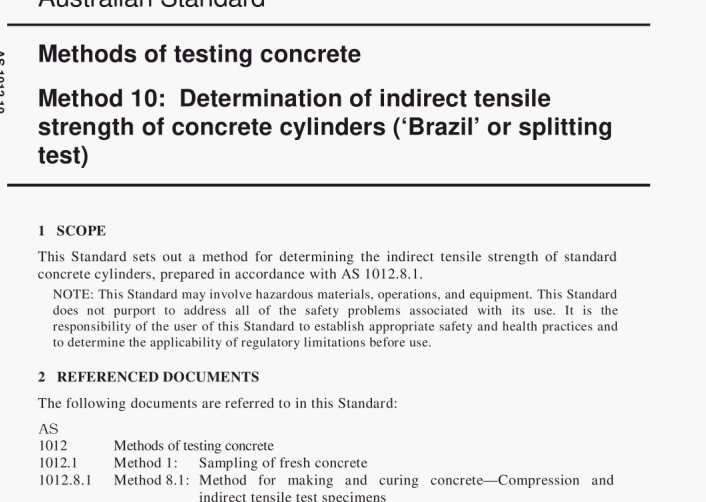AS 1012.10:2000 pdf – Methods of testing concrete Method 10: Determination of indirect tensile strength of concrete cylinders (‘Brazil’ or splitting test).
Each hearing surface of the testing jig shall not depart from plane by more than 0.02 mm.
The bearing surfaces shall be parallel within I degree.
The thickness of the jig bearing plate shall be approximately 20 mm.
4.3 Supplementary bearing bar or plate
Where required, the supplementary steel hearing bar or plate shall have a width of at least 50 mm and a thickness not less than the distance from the edge of the platen to the end of the specimen: or where the upper platen is longer than the test jig, the thickness shall be approximately 20 mm. h shall be at least as long as the specimen.
Each bearing surface of the bar or plate shall not depart from plane by more than 0.1 mm. Each bar or plate shall be used in such a manner that the load will be applied over the entire length of the specimen.
The bearing surfaces shall he parallel within I degree.
4.4 Bearing strips
Two bearing strips of tempered grade hardboard, complying with AS 2458. shall be provided. They shall he free from defects, nominally 5 mm thick, 25 mm wide and at least as long as the specimen. Bearing strips shall not he re-used.
4.5 Vernier calliper
A vernier calliper readable w at least 0.2 mm. and complying with the requirements of
AS 184.
4.6 Ruler
A ruler at least 400 mm long with a scale interest of 0.5 mm.
5 PROCEDURE
The procedure shall be as follows:
(a) Determine the diameter of the test specimen in the test plane to the nearest 0.2 mm by averaging three diameters measured near the ends and the middle of the specimen. Determine the length of the test specimen to the nearest millimetre by averaging at least Iwo length measurements. Make length measurements along the lines in contact with the bearing strips.
(b) Align the hardboard bearing strips between the top and bottom platen of the specimen.
(c) Where necessary, position the supplementary apparatus in the testing machine, so that the specimen is centred over the lower platen.
(d) Apply a small initial force and remove any side constraint (by lowering the side plates in the case of the testing jig illustrated in Figure 1).
(e) Apply the force without shock and increase continuously at a constant rate of 1.5 ±0.15 MPalmin indirect tensile stress until no increase in force can be sustained.
AS 1012.10:2000 pdf – Methods of testing concrete Method 10: Determination of indirect tensile strength of concrete cylinders (‘Brazil’ or splitting test)
